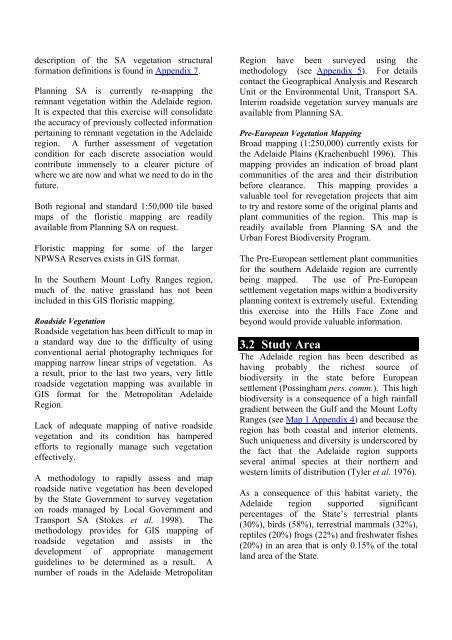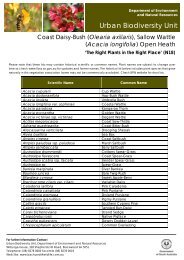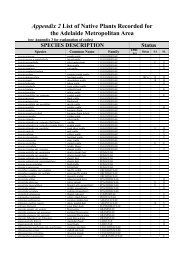Chapter 3 - SA Urban Forest Biodiversity Program
Chapter 3 - SA Urban Forest Biodiversity Program
Chapter 3 - SA Urban Forest Biodiversity Program
You also want an ePaper? Increase the reach of your titles
YUMPU automatically turns print PDFs into web optimized ePapers that Google loves.
description of the <strong>SA</strong> vegetation structural<br />
formation definitions is found in Appendix 7.<br />
Planning <strong>SA</strong> is currently re-mapping the<br />
remnant vegetation within the Adelaide region.<br />
It is expected that this exercise will consolidate<br />
the accuracy of previously collected information<br />
pertaining to remnant vegetation in the Adelaide<br />
region. A further assessment of vegetation<br />
condition for each discrete association would<br />
contribute immensely to a clearer picture of<br />
where we are now and what we need to do in the<br />
future.<br />
Both regional and standard 1:50,000 tile based<br />
maps of the floristic mapping are readily<br />
available from Planning <strong>SA</strong> on request.<br />
Floristic mapping for some of the larger<br />
NPW<strong>SA</strong> Reserves exists in GIS format.<br />
In the Southern Mount Lofty Ranges region,<br />
much of the native grassland has not been<br />
included in this GIS floristic mapping.<br />
Roadside Vegetation<br />
Roadside vegetation has been difficult to map in<br />
a standard way due to the difficulty of using<br />
conventional aerial photography techniques for<br />
mapping narrow linear strips of vegetation. As<br />
a result, prior to the last two years, very little<br />
roadside vegetation mapping was available in<br />
GIS format for the Metropolitan Adelaide<br />
Region.<br />
Lack of adequate mapping of native roadside<br />
vegetation and its condition has hampered<br />
efforts to regionally manage such vegetation<br />
effectively.<br />
A methodology to rapidly assess and map<br />
roadside native vegetation has been developed<br />
by the State Government to survey vegetation<br />
on roads managed by Local Government and<br />
Transport <strong>SA</strong> (Stokes et al. 1998). The<br />
methodology provides for GIS mapping of<br />
roadside vegetation and assists in the<br />
development of appropriate management<br />
guidelines to be determined as a result. A<br />
number of roads in the Adelaide Metropolitan<br />
Region have been surveyed using the<br />
methodology (see Appendix 5). For details<br />
contact the Geographical Analysis and Research<br />
Unit or the Environmental Unit, Transport <strong>SA</strong>.<br />
Interim roadside vegetation survey manuals are<br />
available from Planning <strong>SA</strong>.<br />
Pre-European Vegetation Mapping<br />
Broad mapping (1:250,000) currently exists for<br />
the Adelaide Plains (Kraehenbuehl 1996). This<br />
mapping provides an indication of broad plant<br />
communities of the area and their distribution<br />
before clearance. This mapping provides a<br />
valuable tool for revegetation projects that aim<br />
to try and restore some of the original plants and<br />
plant communities of the region. This map is<br />
readily available from Planning <strong>SA</strong> and the<br />
<strong>Urban</strong> <strong>Forest</strong> <strong>Biodiversity</strong> <strong>Program</strong>.<br />
The Pre-European settlement plant communities<br />
for the southern Adelaide region are currently<br />
being mapped. The use of Pre-European<br />
settlement vegetation maps within a biodiversity<br />
planning context is extremely useful. Extending<br />
this exercise into the Hills Face Zone and<br />
beyond would provide valuable information.<br />
3.2 Study Area<br />
The Adelaide region has been described as<br />
having probably the richest source of<br />
biodiversity in the state before European<br />
settlement (Possingham pers. comm.). This high<br />
biodiversity is a consequence of a high rainfall<br />
gradient between the Gulf and the Mount Lofty<br />
Ranges (see Map 1 Appendix 4) and because the<br />
region has both coastal and interior elements.<br />
Such uniqueness and diversity is underscored by<br />
the fact that the Adelaide region supports<br />
several animal species at their northern and<br />
western limits of distribution (Tyler et al. 1976).<br />
As a consequence of this habitat variety, the<br />
Adelaide region supported significant<br />
percentages of the State’s terrestrial plants<br />
(30%), birds (58%), terrestrial mammals (32%),<br />
reptiles (20%) frogs (22%) and freshwater fishes<br />
(20%) in an area that is only 0.15% of the total<br />
land area of the State.




